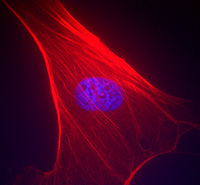Archives
New source studied to ‘grow’ blood vessels
Engineers look to hair-follicle stem cells as way to regenerate tissue
By ELLEN GOLDBAUM
Contributing Editor
For a rich source of stem cells to be engineered into new blood vessels or skin tissue, clinicians may one day look no further than the hair on their patients’ heads, according to new research published earlier this month by UB engineers.

This smooth muscle progenitor cell
derived from a hair folicle expresses calponin (in read), a marker for
smooth muscle cells. The cell nucleus is shown in blue. The image is
magnified 600 times.
“Engineering blood vessels for bypass surgery, promoting the formation of new blood vessels or regenerating new skin tissue using stem cells obtained from the most accessible source—hair follicles—is a real possibility,” said Stelios T. Andreadis, co-author of the paper in Cardiovascular Research and associate professor in the Department of Chemical and Biological Engineering, School of Engineering and Applied Sciences.
Researchers from other institutions previously had shown that hair follicles contain stem cells.
In the current paper, the UB researchers demonstrate that stem cells isolated from sheep hair follicles contain the smooth muscle cells that grow new vasculature. The group recently produced data showing that stem cells from human hair follicles also differentiate into contractile smooth muscle cells.
“We have demonstrated that engineered blood vessels prepared with smooth muscle progenitor cells from hair follicles are capable of dilating and constricting, critical properties that make them ideal for engineering cardiovascular-tissue regeneration,” said Andreadis.
In addition to growing new skin for burn victims, cells from hair follicles potentially could be used to engineer vascular grafts and possibly regenerate cardiac tissues for patients with heart problems.
Since smooth muscle cells comprise the muscle of numerous tissues and organs, including the bladder, abdominal cavity and gastrointestinal and respiratory tracts, this new, accessible source of cells may make possible future treatments that allow for the regeneration of these damaged organs as well.
Andreadis and his colleagues previously engineered functional and implantable blood vessels with smooth muscle and endothelial cells originating from bone-marrow mesenchymal stem cells.
A key advantage of mesenchymal cells is that they typically do not trigger an immune reaction when transplanted, he said.
“Preliminary experiments in our laboratory suggest an exciting possibility—that stem cells from hair follicles may be similar to bone-marrow mesenchymal cells,” Andreadis said.
“The best-case scenario is that from this one very accessible and highly proliferative source of stem cells, we will be able to obtain multiple different cell types that can be used for a broad range of applications in regenerative medicine,” he said.
Co-authors on the paper are Jin Yu Liu, research assistant professor, and Hao Fan Peng, a doctoral candidate, both in the Department of Chemical and Biological Engineering.
The work was funded by the John R. Oishei Foundation. Previous work by Andreadis has been funded by UB's Integrative Research and Creative Activities Fund in the Office of the Vice President for Research.
